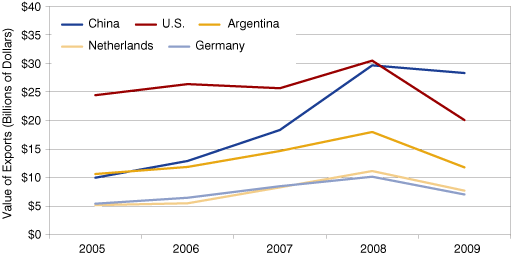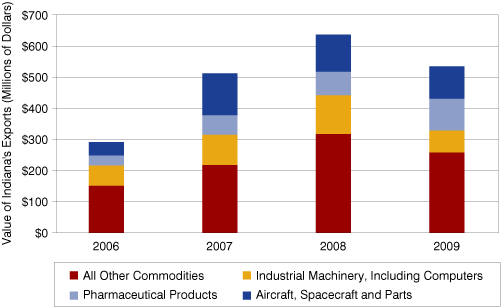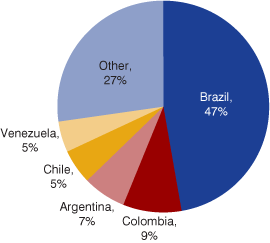Brazil: Countries IN Profile
With 194 million people and covering 3.3 million square miles, Brazil is one of the world’s largest democracies and is the most influential country in South America.1 Brazil emerged from many decades of political turbulence and from military dictatorship in 1989 and has since developed a stable and democratic government. Brazil ranks 75th in the world on the UN Human Development Index, just below Grenada (see Table 1).
Table 1: UN Human Development Index (HDI), 2007
| HDI Measures | Brazil | United States |
|---|---|---|
| HDI Value | 0.813 | 0.956 |
| Life Expectancy at Birth (years) | 72.2 | 79.1 |
| Education Index* | 0.891 | 0.968 |
| GDP Per Capita (PPP** U.S. Dollars) | $9,567 | $45,592 |
*Measures a country's relative achievement in both adult literacy and combined primary, secondary and tertiary gross enrollment.
**Purchasing power parity (PPP) means that the exchange rate is adjusted so an identical good in two different countries has the same price when expressed in the same currency.
Source: Human Development Reports
Trade relations, regardless of the political situation within Brazil, with the United States have not always been cordial. Good relations between Brazil and the United States would likely benefit Indiana. Hoosier industry maintains a significant trading relationship with Brazil and while investment between the two regions may be limited, at least two of Indiana’s largest manufacturers—Eli Lilly2 and CTS Corporation3—have a significant presence in Brazil.
Economy
Figure 1 shows that Brazil has remained largely unaffected by the global recession, maintaining a positive economic growth rate since 1993. However, the nation has not been completely unscathed. Brazil experienced a six-month recession in 2009, largely caused by a rise in food prices that depressed consumer spending.
Figure 1: Annual Growth in GDP, 2000 to 2009

Source: IBRC, using World Bank data
Brazil contains a wide variety of natural resources and at least three distinct ecosystems. One important resource is the recently discovered Tupi oil field, which lies 18,000 feet beneath the Atlantic Ocean and contributes some 5 million to 8 million barrels to Brazil’s estimated 12.6 billion barrel reserves.4
Brazil is the largest recipient of foreign direct investment (FDI) in South America, with the United States as its largest investor. Foreign investment is seen as crucial to driving growth since Brazil’s domestic savings has proven insufficient for capital formation. Despite the importance of FDI, investors often think twice about making investments in Brazil, citing an unfriendly business environment. The lack of a taxation or investment treaty with the United States has hampered American investment.5 Looking at the reverse flow, Brazilian FDI into Indiana has been limited. Since 2003, there has been only one greenfield project—a $9.4 million investment by Gerdau, a Brazilian-based manufacturer of rolled steel.
Trade
Despite Brazil’s continued economic growth, its international exports have experienced a small decline, falling in 2009 to just below their 2006 level, as the economies of Brazil’s major trading partners shrank (see Figure 2). The United States and China are now the largest purchasers of Brazilian exports. U.S. exports to Brazil are dominated by industrial machinery, including computing equipment.
Figure 2: Destinations of Brazilian Exports, 2005 to 2009

Source: IBRC, using WISERTrade data
Indiana’s exports to Brazil declined in 2009, falling by 16.1 percent. Early results for 2010 show a limited turnaround. Indiana’s largest export category is aircraft and spacecraft parts. Most likely these exports to Brazil are a result of the Rolls Royce factory in Indianapolis supplying aircraft engines to Brazil’s growing aeronautics industry, the largest in the southern hemisphere. While the aeronautic industry’s exports dominate Indiana’s trade with Brazil, followed by industrial machinery and pharmaceutical products, together these three commodities account for approximately half of all Indiana’s exports to Brazil (see Figure 3).6 As it happens, the country is also a participant in constructing the International Space Station and the Window Observational Research Facility that was carried into orbit earlier this year by the space shuttle Discovery.7
Figure 3: Indiana's Exports to Brazil, 2006 to 2009

Source: IBRC, using WISERTrade data
Interestingly, Indiana’s largest import category from Brazil is also aircraft and spacecraft parts. Indiana is the 16th largest purchaser of Brazilian exports among the 50 states and ranks fourth in the Midwest. Brazilian purchases account for 2.3 percent of Indiana’s exports and is the state’s eighth largest trading partner (see Figure 4).
Figure 4: Five Largest Purchasers of Indiana's Exports in Latin America and the Caribbean (Excluding Mexico), 2009

Source: IBRC, using WISERTrade data
Three large commodities dominate Brazil’s exports to the rest of the world: iron ore, soybeans and crude oil. The export of iron ore accounts for a significant quantity of Brazil’s trade with China and has contributed to the country's recent emergence as Brazil’s largest trading partner. Brazil has a long history of manufacturing and exporting ethanol, made from sugarcane as an additive to traditional fossil fuels. However, there are significant tariffs imposed on imports of ethanol into the United States, while domestic production is heavily subsidized, severely restricting Brazilian imports.8 These measures have limited the quantity of ethanol imported by the United States. U.S. production of ethanol has increased every year since 2004 (see Table 2). The ethanol production tax credit is scheduled to expire at the end of 2010 and the Brazilian Sugarcane Industry Association has been campaigning vigorously to prevent its renewal.9 However, there is concern in the United States that if these tariffs are discontinued the price of corn will decrease significantly as the market is flooded with cheaper Brazilian ethanol (since the production of ethanol from sugarcane is significantly cheaper than from corn).10
Table 2: U.S. Ethanol Production and Imports (Millions of Gallons), 2004 to 2009
| Measures | 2004 | 2005 | 2006 | 2007 | 2008 | 2009 |
|---|---|---|---|---|---|---|
| U.S. Production | 3,404 | 3,904 | 4,884 | 6,521 | 9,309 | 10,758 |
| Total Imports | 149 | 136 | 731 | 439 | 530 | 198 |
| Imports from Brazil | 86 | 35 | 453 | 185 | 203 | 5 |
Source: U.S. Department of Energy and U.S. Energy Information Administration
Conclusion
Brazil and the United States have an important, if occasionally antagonistic relationship. Ties will likely grow strong in the coming years given America’s need for energy and Brazil’s need for foreign investment. Brazil has been fortunate to side-step the high unemployment and cuts in public spending or large surges in public borrowing that have been the hallmark of this recession for most of the developed countries.
Indiana maintains a significant trading relationship with Brazil and the country remains a major purchaser of Indiana’s aircraft and spacecraft parts as well as a major destination for exports from the Midwest. Given that at least a few of Indiana’s largest companies operate within Brazil, it is in the Hoosier state’s interest that relations between the U.S. and Brazil remain cordial.
Notes
- “Brazil Country Profile”, BBC News, last modified May 28, 2010, http://news.bbc.co.uk/2/hi/americas/country_profiles/1227110.stm.
- “Global Locations,” Eli Lilly & Co, accessed June 30, 2010.
- “Sales Offices and Stocking Distributors,” CTS Corporation, accessed June 30, 2010, www.ctscorp.com/sales/samerica.htm.
- U.S. Energy Information Administration, “Brazil: Oil,” Country Analysis Briefs, last modified September 2009, www.eia.doe.gov/cabs/Brazil/Oil.html.
- “Background Note: Brazil,” U.S. Department of State, last modified February 5, 2010, www.state.gov/r/pa/ei/bgn/35640.htm.
- “The Brazilian Aerospace Industry,” Aerospace Industries Association of Brazil, accessed September 7, 2010, http://www.aiab.org.br/site-ingles/indutria-aeroespacial.asp.
- “Window Observational Research Facility (WORF),” NASA, last modified June 25, 2010, www.nasa.gov/mission_pages/station/research/experiments/358.html.
- “Brazil Announces Temporary Elimination of Ethanol Tariff,” National Association of Convenience Stores, last modified April 7, 2010, www.nacsonline.com/NACS/News/Daily/Pages/ND0407105.aspx.
- Timothy B. Hurst, “Brazilian Sugarcane Industry Takes Aim at U.S. Ethanol Policy with Clever PR Campaign,” Ecopolitology, last modified September 29, 2010.
- James Jacobs, “Ethanol from Sugar: What Are the Prospects for U.S. Sugar Co-ops?” Rural Cooperatives, September-October 2006, http://www.rd.usda.gov/files/CoopMag-sep06.pdf.
Matthew Hutchinson
Research Assistant, Indiana Business Research Center, Indiana University Kelley School of Business
